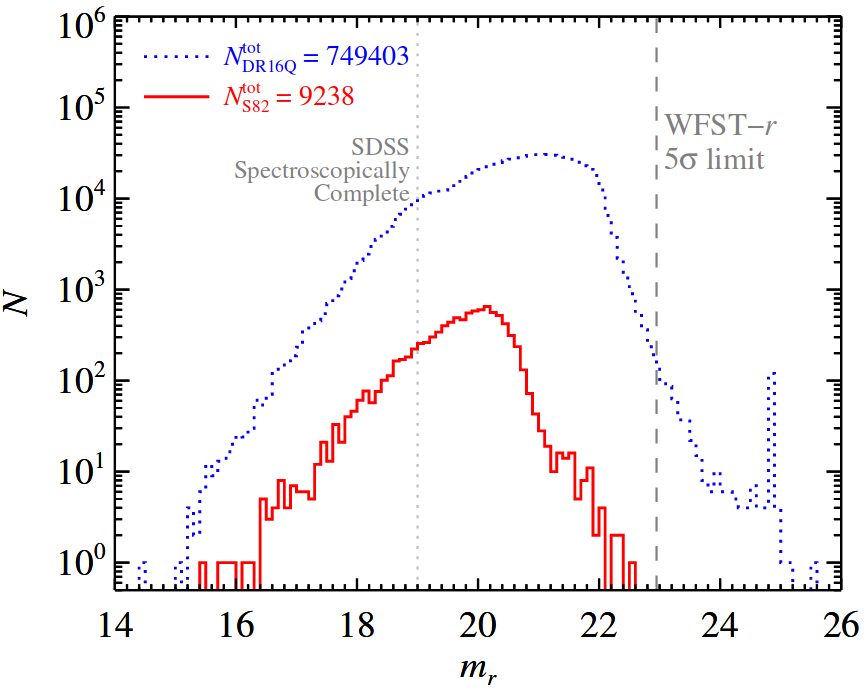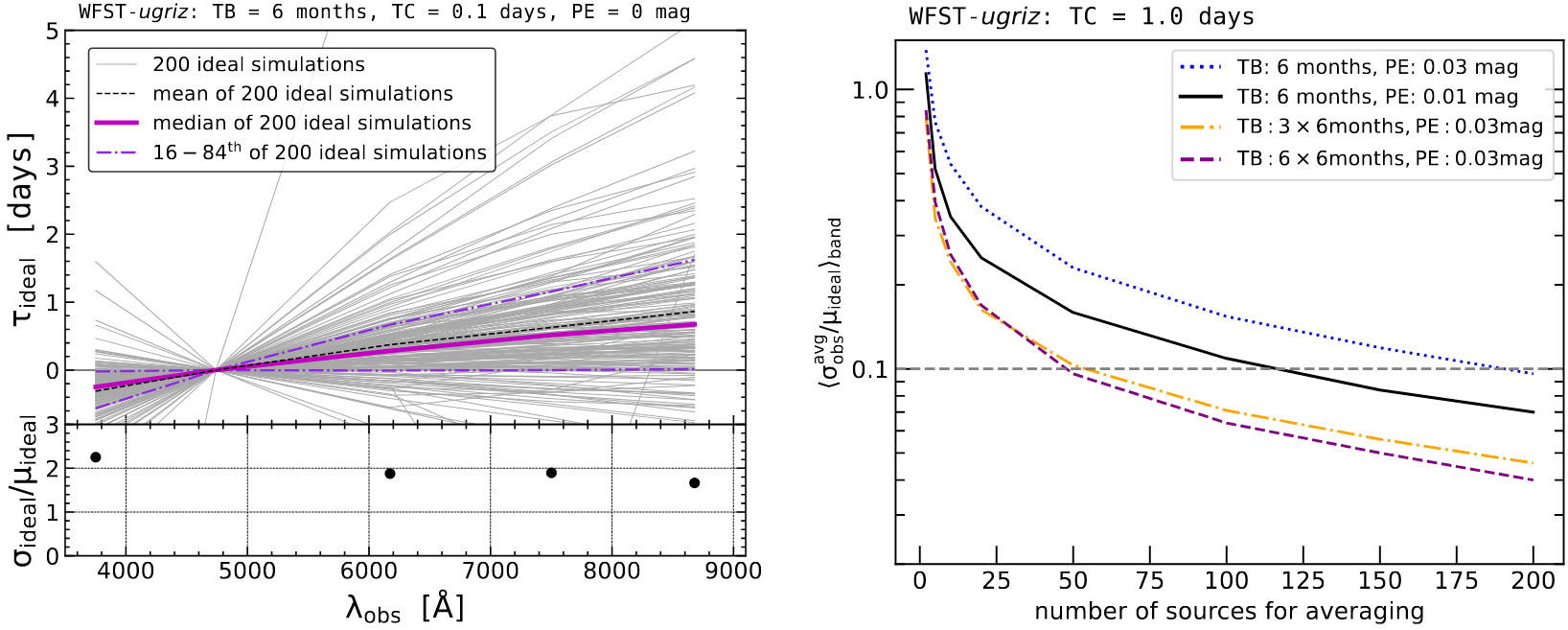
Figure 1, Distributions of the apparent r-band magnitudes for spectroscopically confirmed quasars in the Stripe 82 (S82; red solid histogram; [157]) and in the SDSS 16th data release quasar catalog (DR16Q; blue dotted histogram; [158]). Note that only quasars with physical r-band magnitudes are used here. Shown for comparison are the spectroscopically complete limit of ∼ 19 mag for SDSS quasars (light-gray dotted vertical line) and the WFST r-band 5σ detection limit of ∼ 22.9 mag in a single 30-sec exposure (gray dashed vertical line).
The ongoing and forthcoming intensive time-domain surveys play a pivotal role in elucidating the enigmas surrounding Active Galactic Nuclei (AGNs), which are predominantly unresolved in spatial terms. Employing the same five photometric passbands as the Sloan Digital Sky Survey (SDSS) and boasting an impressive 5σ detection threshold of approximately r ∼ 22.9 magnitude during a brief 30-second single-epoch exposure (as depicted in Figure 1), we anticipate that the Wide Field Survey Telescope’s Deep High-Cadence Survey (WFST DHS) and Wide Fast Survey (WFS) will provide decade-long light curves encompassing five passbands for virtually all SDSS quasars. This is especially pertinent for a substantial fraction of these quasars that may not be observable by the Large Synoptic Survey Telescope (LSST) situated in the southern hemisphere.
Moreover, the WFST surveys are poised to extend the existing light curves to encompass several decades for quasars situated within the region of Stripe 82 (S82) and the ten medium-deep fields originally surveyed by Pan-STARRS1 (PS1). This will impart a profoundly valuable WFST legacy dataset to the AGN research community. These novel light curves spanning decades will facilitate the exploration of the underlying physical mechanisms responsible for AGN variability across extended timescales. Furthermore, they will provide valuable insights into the fainter end of the AGN population, which includes black hole masses that are presently beyond our observational reach.
The extension of the observational baseline with WFST will markedly enhance our ability to identify and characterize new and rare events associated with AGNs. Additionally, owing to the forthcoming deep and high-resolution images from WFST, we can foresee the construction of a sample of closely situated AGN pairs, enabled by their distinctive AGN-specific color properties. This development opens up the possibility of investigating the mechanisms triggering AGN activity.
Furthermore, the long-term variability captured in conjunction with deep WFST stacked images, reaching depths of approximately r ∼ 25 magnitude, will be invaluable for identifying and characterizing quasar candidates fainter than the completeness limit achievable with SDSS spectroscopy. These identified quasar candidates will subsequently become readily observable targets for future major spectroscopic initiatives (e.g., the LAMOST-II and MUST programs). These endeavors are dedicated to probing even fainter AGNs at higher redshifts, often characterized by lower black hole masses. The ultimate objective of these efforts is to assemble a comprehensive portrait of black hole growth, its co-evolution with galaxies, and to trace the cosmological evolution of the intergalactic medium and the large-scale structure of the universe.
(1) Physical Origin of AGN Optical Variability
In the era of time-domain astronomy, accurately measuring the timescale and variation amplitude of Active Galactic Nuclei (AGN) variability stands as a fundamental objective. The WFST legacy survey, with its ability to extend existing quasar light curves over several decades, is poised to play a crucial role in precisely determining the timescale of variation, potentially spanning multiple years. As depicted in the left panel of Figure 2, when considering AGNs akin to NGC 5548 and their observations across the five WFST passbands, the disk turbulence model provides predictions for the intrinsic dispersion of the inter-band time lag as a function of wavelength. These predictions exhibit apparent alignment with current preliminary observations.

Figure 2, Left panel: relative to WFST-g band, the intrinsic inter-band timelag as a function of wavelength implied by the disk turbulence model [167] for AGNs akin to NGC 5548 observed yearly in WFST-ugriz passbands, assuming a temporal baseline of 6 months per year, a temporal cadence of 0.1 day, and without photometric error (Z. B. Su et al. 2023, in preparation). In the top subpanel, gray thin solid lines show results of individual simulations, while the median/mean and 16%-84% percentile ranges are shown accordingly. In the bottom subpanel, the intrinsic uncertainty of individual timelag in each band is quantified as the ratio of the corresponding dispersion σideal to the mean timelag μideal. Right panel: considering a real temporal cadence of 1 day in the WFST DHS and photometric errors of 0.01-0.03 mag, the observed uncertainties of the mean timelag decreases significantly with increasing the number of sources used in averaging and especially with increasing the cumulative observations from one year to three and six years.
An accuracy level of ≲ 10% - 30% for the measured time lag can be readily achieved. This accuracy can be achieved through the averaging of observations from hundreds of AGNs characterized by comparable black hole mass and luminosity. This outcome is achievable even when considering data from only the first year of observations (as indicated in Figure 2, right panel). The accumulation of data over a period of six years is expected to yield even greater accuracy in the measurement of time lags.
Moreover, the approximately 700 square degree deep drilling fields, which WFST will monitor frequently, surpass the size of those in the Pan-STARRS1 Medium Deep Survey and those intended for the Large Synoptic Survey Telescope (LSST). This extended coverage is anticipated to yield significant advancements in AGN research. In addition to assessing the time lags between different wavelengths, these deep drilling fields present a unique opportunity to investigate the true variable Spectral Energy Distributions (SEDs) of AGNs. Furthermore, they enable the exploration of timescale-dependent color variations in AGNs, which represents a novel approach for probing and testing accretion disk physics in the realm of time-domain astronomy. Collectively, these factors underscore the potential of the WFST legacy survey to enhance our comprehension of AGN variability physics.
(2) Particular AGN Variability
In the current time-domain era, the continuous monitoring of Active Galactic Nuclei (AGNs) has brought to light known forms of AGN variability, the underlying physical origins of which remain mysterious. With the support of archival data, the WFST surveys are poised to contribute significantly by enabling the creation of light curves spanning several decades and the characterization of two distinct types of AGNs, namely Extreme Variability (EV) and Continuous Low-level (CL) AGNs.
Periodically varying quasars, a subset of AGNs, are particularly intriguing as they are considered candidates for supermassive Black Hole Binaries (SMBHBs). Several SMBHB candidates have already been reported, and a recent study by Liu et al. identified 26 SMBHB candidates from a sample of approximately 9,000 color-selected quasars within a 50 square degree region of the Pan-STARRS1 Medium Deep Survey. The WFST surveys hold the potential to confirm these SMBHB candidates and potentially identify new ones, particularly if deep fields larger than those covered by Pan-STARRS1 are monitored.
Of note, the decades-long light curves generated by the WFST survey will greatly aid in the search for unusual AGNs, including those displaying monotonically increasing or decreasing variations, minimal variability over extended timescales, and AGNs that genuinely turn on or off. This line of investigation could represent a pivotal step towards unraveling the mechanisms responsible for triggering AGN activity.
(3) Low-luminosity AGNs and IMBHs
Variability has proven to be a valuable tool for distinguishing genuine Active Galactic Nuclei (AGNs) from star-forming galaxies. This approach has led to the discovery of a significant number of Intermediate-Mass Black Hole (IMBH) candidates in dwarf galaxies, including those with active star formation that had largely gone unnoticed in previous studies. Recent research has revealed a correlation between the characteristic timescale of optical variability and the mass of the central Black Hole (BH). This correlation opens up the possibility of identifying IMBH candidates based solely on photometric variability.
The high-resolution images that will be captured by the WFST represent a significant improvement over current time-domain optical surveys. These high-resolution images will greatly reduce the contamination of stellar light from host galaxies, making reliable photometry of these faint AGNs possible. As a result, active IMBH candidates can be detected not only in isolated dwarf galaxies but also in close dwarf companions of larger galaxies or even in the stripped cores of dwarf galaxies within massive galaxies. When combined with a high-cadence observation strategy in fields with frequent monitoring, these photometric measurements hold the promise of constructing a substantial sample of IMBHs, complete with estimates of their Black Hole masses.
(4) Off-nucleus AGNs
Off-nucleus Active Galactic Nuclei (AGNs) are characterized by their spatial offset from the central nucleus and their physical connection to nearby companion galaxies. The high-resolution, multi-band imaging capabilities of WFST will allow us to construct a sample of AGNs with smaller offsets, providing insights into the crucial phases closer to the merger event. Moreover, this enhanced imaging capacity will enable us to create a more statistically comprehensive sample, facilitating investigations into relevant physics both before and after galaxy mergers.
Additionally, a novel method for identifying off-nucleus AGNs or close AGN pairs based on their color variation properties, such as the “bluer-when-brighter” trend, is currently in development. WFST’s observations will contribute to the discovery of off-nucleus AGNs, and the nature of these AGNs will be further explored when extremely high-resolution images from the Chinese Space Station Telescope (CSST) become available.
(5) Strongly-lensed AGNs
The discovery of strongly-lensed Active Galactic Nuclei (AGN) systems traditionally relies on methods involving imaging and spectroscopy. However, recent developments in variability-based methods have opened new possibilities, particularly with ongoing and upcoming time-domain surveys. According to a simulation conducted by Oguri et al., there are, on average, approximately 0.06 galaxy-scale strongly-lensed AGN systems per square degree. These systems typically have two or three lensed images that are brighter than i = 22 mag. Consequently, we anticipate that WFST will detect around 500 strongly-lensed AGN systems, offering a unique opportunity to collect multi-band, high-cadence light curves for these systems. This extensive legacy dataset has the potential to make significant contributions to various areas of astrophysical research.